by Prof.
David N. Nikogosyan, University College Cork, Cork, Ireland
(click on photos to enlarge image)
MARKS OF EUROPEAN SILVER PLATE: I. SANDRIK, SLOVAKIA
Collecting silver-plate objects, I usually try to choose
those in better, if not perfect, state. The teapot from my
collection that I am going to introduce here was found at a
village market in the Balaton region of Hungary in 2001.
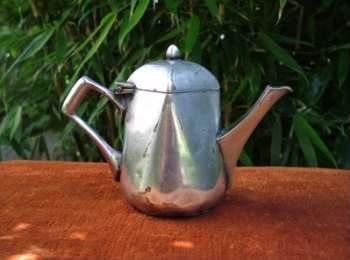 |
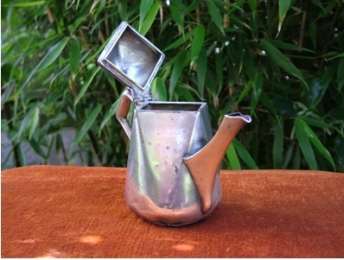 |
An unidentified 25 cl teapot with an original
design
|
|
Though this object had numerous dings and dents and a small
hole in the bottom, I immediately bought it for 2000 forints
(about 10 $). The reason I liked it was its original design. The
round bottom transformed smoothly to the quadratic head and
besides the teapot possessed a very expressionist looking spout
and handle. I was so proud of my finding and simultaneously very
sad that it was impossible to study the mark, as it was
absolutely unclear.
 |
An unreadable inscription on the teapot
bottom
|
Four years later, in 2005, I bought on ebay.de a small
silver-plated 12 cl creamer possessing a similar inscription
with the circle in the center of the same diameter, 3.9 mm.
Inside this circle I easily read SANDRIK.A.S., which means
SANDRIK Alpacca Silber (or Alpakove Striebro in Slovak
language).
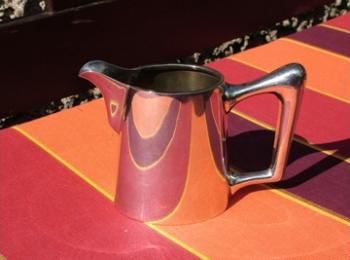 |
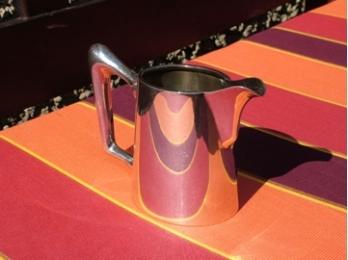 |
12 cl silver-plated Sandrik creamer
|
|
 |
An inscription on the creamer bottom with the
Sandrik mark
|
Later, in 2007, in Berlin (Charlottenburg antique market) I
acquired another piece of Sandrik silver plate, a large 150 cl
teapot , with a slightly smaller round mark, 3.4 mm in diameter,
but of similar design .
150 cl Sandrik silver-plated teapot and its
bottom inscription with the Sandrik mark
|
According to the stylistic features, I guess that the large
teapot was made in the beginning of the XX century before World
War I, while the little teapot and the creamer were produced
after World War I.
Recently I purchased in Hungary a silver-plated
ladle from Sandrik. It contains the above-described
mark, set not inside the circle but inside the rhomb
with a vertical diagonal of 5.1 mm (right).
By analogy with a mark used at the same time by the
famous Arthur Krupp metalware factory in Berndorf,
Austria-Hungary (this firm had close relations with
Sandrik), it should be related to low-quality silver
plate.
|
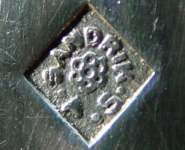 |
 |
Sandrik silver-plated ladle
|
Finally, in the Dorotheum auction house in
Vienna, I found a beautiful art-nouveau
silver-plated fruit dish made by Sandrik (right),
bearing an inscription in Czech "MESTSKÝ DUM" (which
means city hall) and a similar mark of low-quality
silver-plating, set inside the rhomb with a diagonal
of 4.5 mm. This mark contains also the additional
letters A.S., which mean "Alpacca Silber". I would
also suggest that the smaller size of the rhomb
refers to earlier years of production.
|
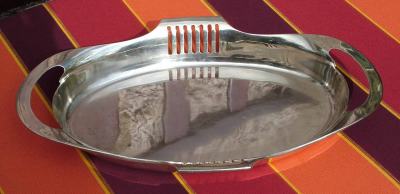 |
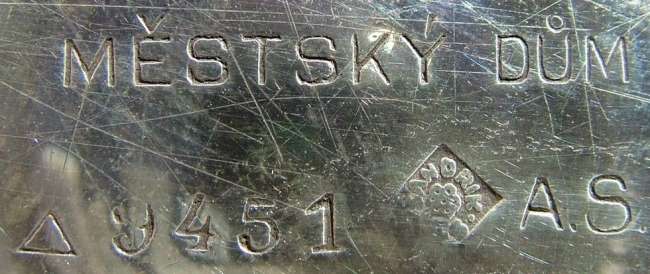 |
The inscription on the bottom of Sandrik
fruit dish
|
Now a few words about the history of this factory.
In 1752 the Dutch aristocrat Jan Joseph Geramb came to Slovakia.
He was very successful in the mining business. At the end of the
18th century he founded the so called Geramb Mining Union (GBU)
that was the strongest and the most profitable company not only
in the mining area, but also in the whole Austrian-Hungarian
monarchy. In the middle of the 19th century the GBU employed
1400 people and apart from the mining of common metals (copper,
lead, zinc), at the time of the best prosperity, the company
annually extracted on average 28.3 kg of gold and 3,194 kg of
silver. The prosperity of GBU lasted until the end of the 19th
century. Unfortunately, after the discovery of rich silver
deposits in South Africa and America, the world price of 1 kg
decreased more than twice.
The deep mining used in the GBU didn’t allow the extraction of
the metal for a lower price. The mines and GBU were just about
to become bankrupt. The businessman Robert Berks decided to
transform the extracted metals into final products. In 1895 he
founded a factory for the processing of silver in Dolne Hámre (now
Hodruša-Hámre, central Slovakia). He chose land which belonged
to Johanes Sandrik. The company was given its name after the
land it had been built on. Berks chose as a graphic trade mark
the six-petal rose which was adopted from the Geramb coat of
arms. According to the Berks project, the factory was supposed
to process 10,000 kg of silver per year.
In 1895 (or 1896) the designer and graduate of the Wiener Kunst Schule
(Vienna Art School), Jan Peterka, started to work in Sandrik.
According to the condition of the Budapest´s government for
providing a financial loan, the factory was supposed to take part in the
Millenium exhibition in Budapest in 1896 and also in the World exhibition
in Paris in 1900 with its own designed products.
Young Peterka coped with the task so successfully that
the objects designed by him were awarded gold medals at the both
exhibitions. For that success, the 29 years old Peterka was put
in charge of the factory. He stayed in this position until 1929.
The factory was active until World War II. After the war it was
nationalized and fused with the Czech firm Bibus.
After the Velvet Revolution, Sandrik was reopened. The Austrian
investor Berndorf gained a 100 percent share in Sandrik in 1994.
LITERATURE
1. Hodruša-Hámre, History of the village Dolne Hámre,
http://www.hodrusa-hamre.sk/en/
2. Dedo von Kerssenbrock-Krosigk and Claudia Kanowski: Modern
Art of Metallwork (Berlin: Bröhan Museum, 2001), pp. 552, 555.
Prof. David N. Nikogosyan,
University College Cork, Cork, Ireland
- 2008 -
|
|
|
 ASSOCIATION OF SMALL COLLECTORS OF ANTIQUE SILVER
ASSOCIATION OF SMALL COLLECTORS OF ANTIQUE SILVER ASSOCIATION OF SMALL COLLECTORS OF ANTIQUE SILVER
ASSOCIATION OF SMALL COLLECTORS OF ANTIQUE SILVER